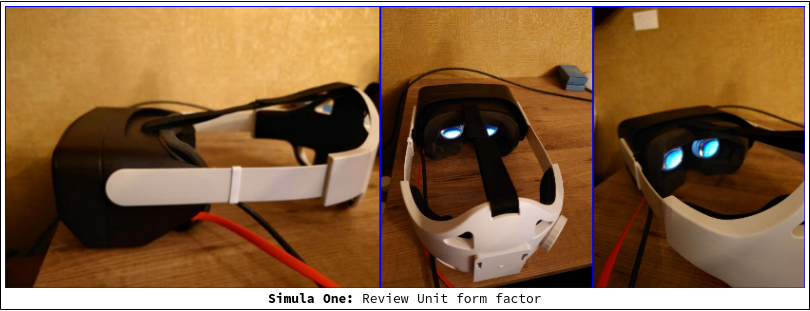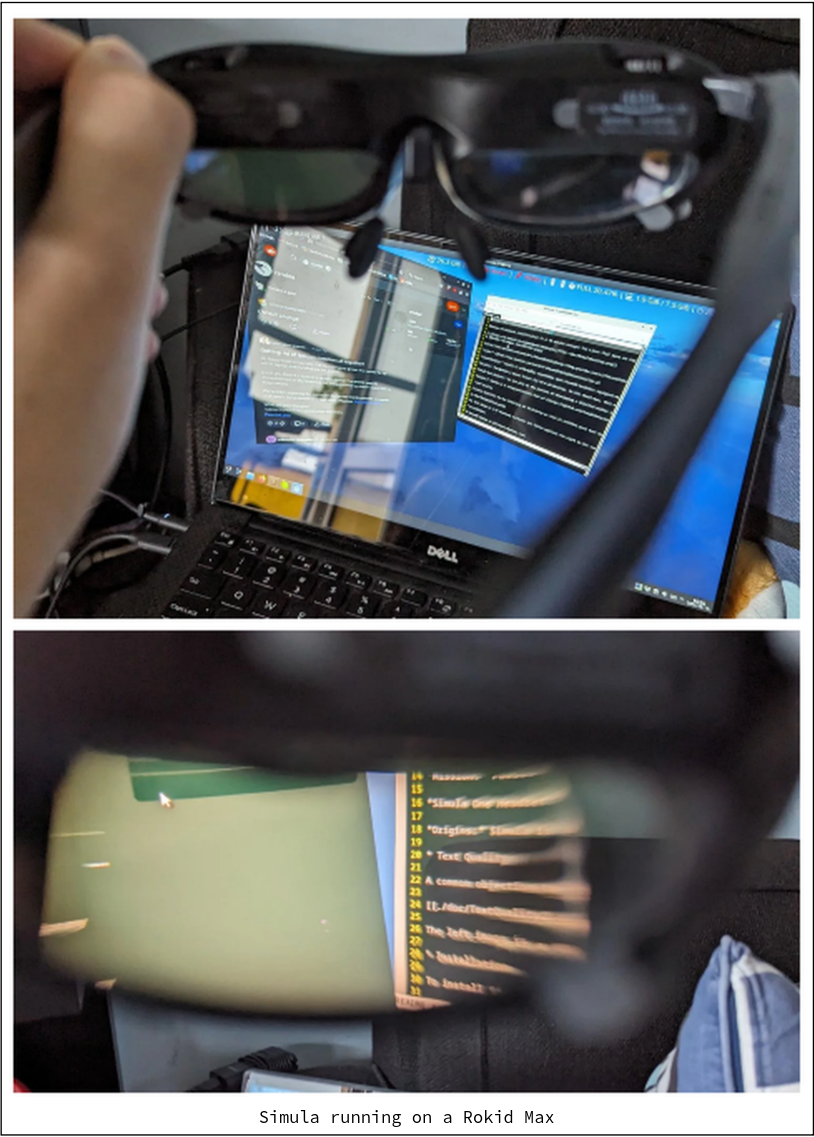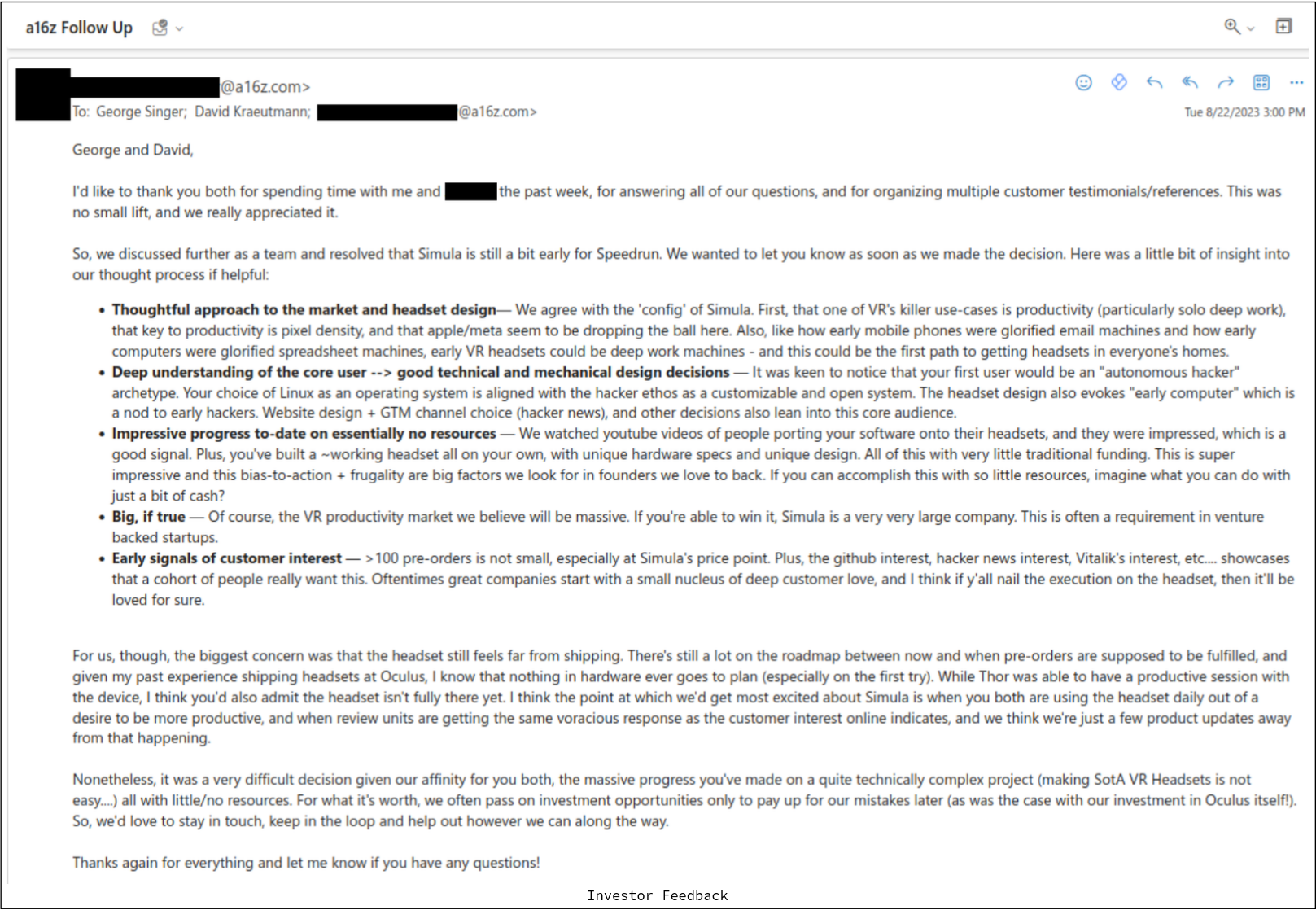Due to capital constraints, we are unable to meet our delivery deadline by EOY 2023 for Simula One preorders, and are pushing our optimistic shipdate to Q2 2024 (with a pessimistic ship date of Q4 2024). In this post we discuss our capital situation, mistakes we made, Review Unit testimonials, & investor feedback.
1 Capital Constraints
The main issue impeding our faster progress over the past few months has been capital.
The immediate constraint: The immediate constraint is our inability to make a timely payment for the mass production of our VR displays. Lead time has increased due to this limitation to up to 40 weeks. It's possible that this can be be expedited, but at the moment we cannot put in the order until we obtain more capital.
The more fundamental constraint: We're currently $1.2M short of the project's total cost. Even though we've made lots of progress by using influxes of capital for specific headset components, we've hit a stage where our fundamental bottleneck is our inability to batch order our components and incur the large NRE expenses that we've been putting off.
Below is a more detailed overview of our capital situation, including our preorder & investment stats.
2.1 Preorder & Investment Stats
We started the project with the backing of angel investors, who committed $285K over the course of 2021-2022. Since launching our store in 2022, we received an additional $329K in the form of headset preorders (roughly 16% as Founders Edition units, and 84% as standard units). This year we also started raising SAFEs while looking for institutional capital.
| Amount | |
|---|---|
| Starting Capital (2021-2022): | $285K |
| Preorders (2022-2023): | $329K (116 units) |
| Recent Investments (2023 SAFE Investments) | $130K |
| Total Cash Involved: | $744K |
2.2 Updated Overview of Our Capital Model
We've been working towards the mass production of our first batch of headsets, the remaining costs of which can be divided into 3 categories:
- Variable costs (components). Principle components include raw materials, displays, lenses, NUC compute units, carrier boards, batteries, and cameras. Also included are things like fasteners, screws, and springs.
- Labor costs (annually recurring). Includes salaries for our existing 3-person team, assembly labor (which scales with batch size), and money to hire additional engineers (also scales with batch size). We also include a small allocation towards legal and accounting expenses.
- NRE costs (capital expenditures). Includes CNC, injection mold tools, assembly line setup (fixtures, applicators, fastening tools, etc), and lens tooling. A few of our suppliers also pass on some of their own NRE to us. We also include an allocation for regulatory compliance & testing.
While there is still some flex in our assumptions (for e.g. how much runway we give ourselves), this gives a rough idea of our costs remaining for our first batch, and second thereafter. Each category also includes a 10% buffer.
| 125 Units (Non-Ideal Batch 1) | 250 Units (Ideal Batch 1) | 1,000 Units (Batch 2) | |
|---|---|---|---|
| Variable Costs (Components) | $376,158.11 | $635,790.10 | $1,987,499.80 |
| Labor Costs (Annually Recurring) | $396,000.00 (1 year of runway) | $396,000.00 (1 year of runway) | $1,920,000.00 (2 years of runway) |
| NRE Costs (Capital Expenditures) | $373,480.00 | $373,328.00 | $0.00 (paid for from batch 1) |
| Total | $1,145,638.11 | $1,404,118.10 | $3,907,499.80 |
Ideally, we are targetting a 250 unit batch size, which puts us in a position to ship all oustanding units while still having some left over to fund a second iteration. This would require a $1.4M Seed check, and is what we've been targeting with VCs.
2.3 Our Mistakes
When we launched our preorder store, we decided to not use Kickstarter in order to (i) take preorders beyond the 60 day Kickstarter limit, (ii) allow for partial deposits, and (iii) avoid fees. At the time we started the campaign, our target was to have ~900 headset preorders filled within ~6 months (a number we came to by extrapolating off of email signups). In retrospect, we came far short of this target.
Initially, our sales started off with a spike: in our first month, we raised $223K. After this, our sales stalled (with some spikes in the summer and during the Holiday season). During this period, we thought that demonstrating engineering progress would most boost enthusiasm for our product (for both customers and potential investors), and focused primarily on getting a headset prototype finished and shipped to our first tester (Vitalik Buterin).
We didn't start raising institutional money until after achieving this milestone (last Spring) and, in retrospect, one of the biggest mistakes we made was not starting this process earlier (either before the project started, or at the very least right when our sales spiked after launching the campaign). While we've been making progress raising small checks – allowing us to cover our engineering bills and to make progress on our headset design – we are now primarily bottlenecked by our inability to batch order our components and to incur the large NRE expenses that we've been putting off.
3 Testimonials on our Review Unit

We appreciate Vitalik Buterin and Thor Kampefner for being the first two testers of our early Review Unit (our early prototype headset running Arch Linux – as a temporary OS – on top of our software stack). Recently, Thor gave us a testimonial saying he was able to get sessions as long as 2.5 hours out of it:
Some rough edges notwithstanding, I'm generally excited about the state of the headset. Some parts of the experience I'd want to highlight:
- Productivity: The headset still feels work in progress, but I'm already impressed with the productivity experience. At home, I have 4 32-inch monitors at home and a standing desk, but the headset gives me more visual real estate for screens. My whole home desk setup costs about as much as the base Simula headset right now, but I can travel with the headset making it attractive for productivity. I wouldn't want to wear the headset all day, but can easily wear it for a few hours at a time. Also, since I use PopOS (Linux) for my desktop environment, it was relatively easy to set up the headset similarly to my desktop. This seems like a big advantage for me personally, and probably for the about 3% of desktop users who use Linux. For non-Linux users, I think the headset is a tougher sell; I think Simula is addressing a segment of users like myself who would not want to invest in a Meta or Apple device.
- Autonomy: I'm personally willing to tolerate rough edges in the experience, if it means I have autonomy from the kinds of telemetry that large technology companies are famous for. I like that Simula is open source and open hardware. It gives me peace of mind that I can make changes to the experience based on things that I might want, and that I don't risk being surveilled for user data, or getting locked out of features by the pernicious whims of distant executives. A Linux based OS also means I can hack on my own headset, and participate in a community of others doing the same.
- Getting Started: I've installed Arch Linux before–on which the Simula OS is based–and didn't have too much trouble getting started, but I'm likely in a pretty small minority here. I suspect the user experience will change and improve over time with the Simula headset, but I also expect the VR hacker community to be a big part of that growth.
- Major pain points: Hardware still seems pretty unpolished in the review board, which is generally what I expected. Arch Linux is still Arch Linux. My longest stretch using the device so far was about 2.5 hours, at which I was feeling a little eye-tired, but I could put the headset back on later without feeling strained.
And here was our response outlining how we plan to fix these issues:
We're super glad you got some 2.5hr sessions out of it (even in its unpolished state)! Thanks for sending your testimonial over. Couple of thoughts on your feedback:
RE Arch Linux: Yes, Arch Linux is a notoriously bare bones and hard to use distro, but we only used it as the basis for your and Vitalik’s Review Unit. :] The Simula One itself (and other Review Units we’re putting into circulation now) are actually based off of NixOS, and our goal is to morph the default OS UX into something very user friendly out of the box. In general, Linux Desktop has millions of users who aren’t necessarily hardcore hackers, and so our goal is to make the headset accessible to a wide user base (while still giving people freedom to customize as they wish).
RE solving eye fatigue: Two causes come to mind which are being addressed in the more polished unit:
Fixing IPD adjustment. Misaligned IPD can be a big cause of eye fatigue over long sessions, and our current Review Unit has a really poor IPD system (that essentially locks it into place). We’re working on an automatic IPD system to get around this issue for our final unit.
Light leakage. The foam facial interface needs polish, and the 3D printed parts the headset is using (e.g. the lens housing) are not fully opaque. Both of these issues allow light to leak into the lenses, which causes eye fatigue over long sessions. We're solving this by the final release.
Bottom line: we expect you to get much longer than 2.5hr sessions out of our final unit!
5.1 People using Simula on other headsets
When it comes to our software, we recently saw that people are starting to run our window manager on some newly released headsets. Here's someone running Simula on a Rokid Max (a Linux compatible AR headset with decent PPD, though it's tethered and has pretty low FOV):

4 Investor Feedback
We recently talked with a16z about funding for Simula. Here is the feedback they gave us:
5 We Need Your Help
We're seeking investing partners who align with our mission to create office-focused VR computing headsets built over Linux. If you're an investor who shares enthusiasm for this goal (or know someone who does), please don't hestitate to reach out to us.
Our core thesis: While most people think the future of VR is primarily in games & entertainment, the truth is that VR offers a superior way for performing knowledge work: more screens, bigger screens, improved immersion, improved focus, more privacy, and fully portable freedom of movement. In VR you can sit up, lean back, walk or even lay down while you compute...all in a compact form factor that saves on desk space.
With the upcoming release of Apple's headset, the age of ubiquitous VR computing is now closer than ever. Yet despite it being more than 10 years since the release of the original Oculus (DK1), people still cannot use any VR headset to realistically replace their laptops (and this will not change with the release of the Vision Pro). While we expect consumers to be really excited about a VR takeoff in 2024, we want to give people an alternative to Meta and Apple: one that is based on Linux Desktop instead of the Android/iOS ecosystems their headsets are built over, and one which is focused on productive desktop computing over casual gaming, social networking, or the passive consumption of entertainment.
